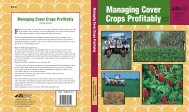A Study to Determine the Preference for Nesting Box Design of ...
A Study to Determine the Preference for Nesting Box Design of ...
A Study to Determine the Preference for Nesting Box Design of ...
Create successful ePaper yourself
Turn your PDF publications into a flip-book with our unique Google optimized e-Paper software.
It is difficult <strong>to</strong> determine whe<strong>the</strong>r <strong>the</strong> Peterson boxes enhanced fecundity <strong>for</strong> any <strong>of</strong> <strong>the</strong> three species<br />
nesting along <strong>the</strong> trail, not only due <strong>to</strong> <strong>the</strong> low nesting activity in <strong>the</strong> Peterson boxes, but because <strong>of</strong> <strong>the</strong><br />
numbers <strong>of</strong> eggs and chicks lost <strong>to</strong> predation. Five clutches (3 bluebird and 2 chickadee) were lost <strong>to</strong><br />
preda<strong>to</strong>rs. This was <strong>the</strong> highest number <strong>of</strong> nests lost <strong>to</strong> preda<strong>to</strong>rs during <strong>the</strong> 6 years <strong>of</strong> study at <strong>the</strong> site.<br />
Two nests were lost during <strong>the</strong> 2011season (Burkart et. al, 2011), 3 clutches during each <strong>of</strong> <strong>the</strong> 2009 and<br />
2010 seasons (Burkart et. al., 2009, 2010), and 1 nest each during <strong>the</strong> 2007 and 2008 seasons (Burkart<br />
et. al., 2007, 2008). All 3 nests in field 2 were lost <strong>to</strong> predation. It is most likely that <strong>the</strong> bluebird nest in<br />
box 13A was most likely lost <strong>to</strong> a bear. The box was pulled open and <strong>the</strong> chicks were missing. The same<br />
thing happened <strong>to</strong> box 13A during <strong>the</strong> 2008 season, when a black bear was reported in <strong>the</strong> area (Burkart<br />
et. al., 2008). The clutches lost from boxes 9A and 12B in field 2 may have been lost <strong>to</strong> snakes. A week<br />
after <strong>the</strong> eggs went missing from box 9A, a large black snake was observed sunning on <strong>the</strong> path just<br />
down from <strong>the</strong> box (figure 4). Two clutches were lost in field 1, one from box 2A and one from box 6A.<br />
Nests in field 1 have experienced less predation over <strong>the</strong> years, most likely due <strong>to</strong> <strong>the</strong> electrified fence<br />
that surrounds <strong>the</strong> field and <strong>the</strong> height <strong>of</strong> <strong>the</strong> grass in most areas. Unlike field<br />
Figure 4. Black snake found along <strong>the</strong> road in field 2 one week after eggs disappeared from box 9A. The<br />
clipboard is 34.3 cm in length.<br />
2, <strong>the</strong> grass in much <strong>of</strong> field 1 is kept short or relatively short by frequent mowing or <strong>the</strong> activities <strong>of</strong> <strong>the</strong><br />
cattle that are in <strong>the</strong> field during <strong>the</strong> spring. For <strong>the</strong> next season, snake deterrents will have <strong>to</strong> be<br />
devised that will work on <strong>the</strong> fence posts in field 2.<br />
34
















